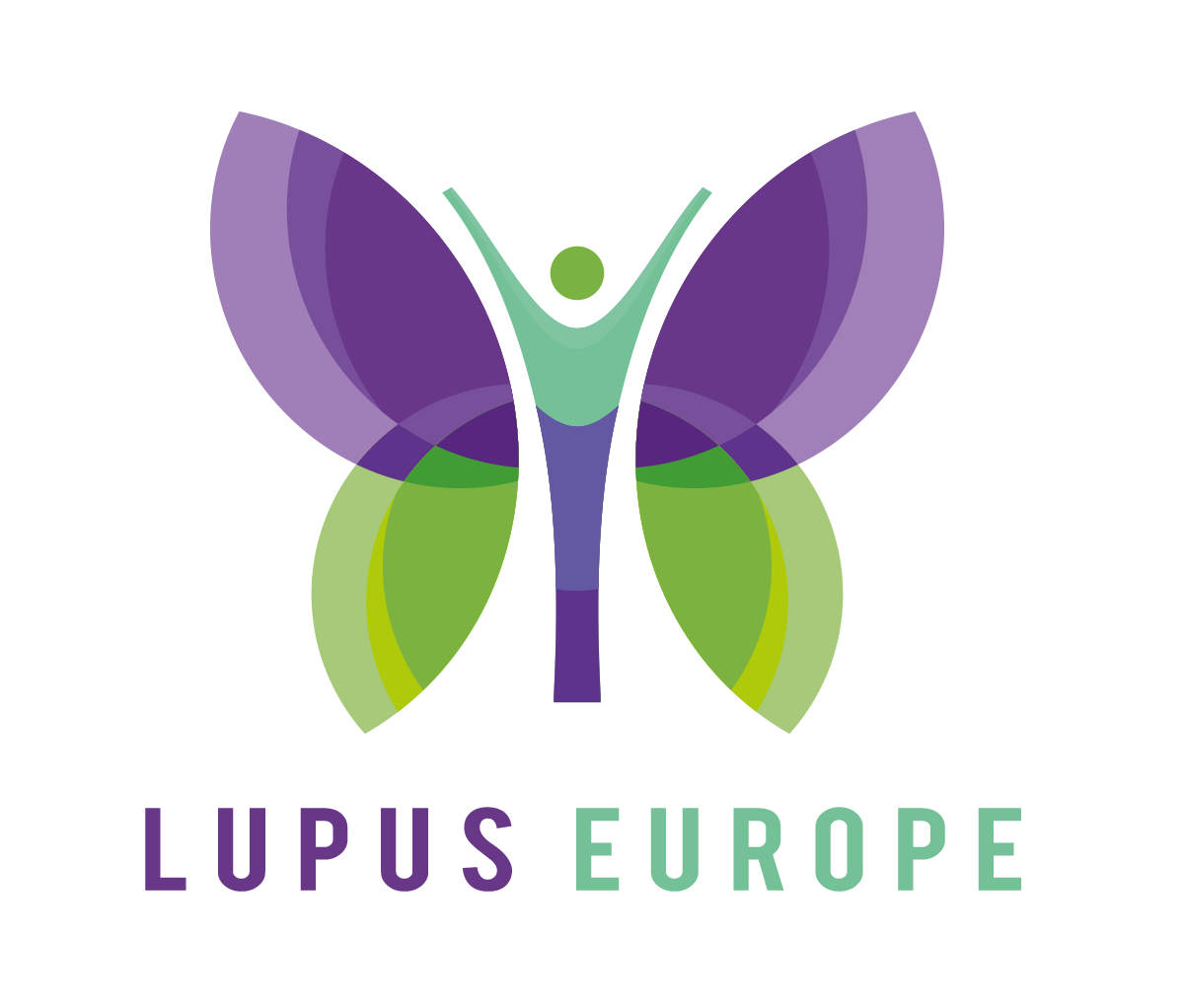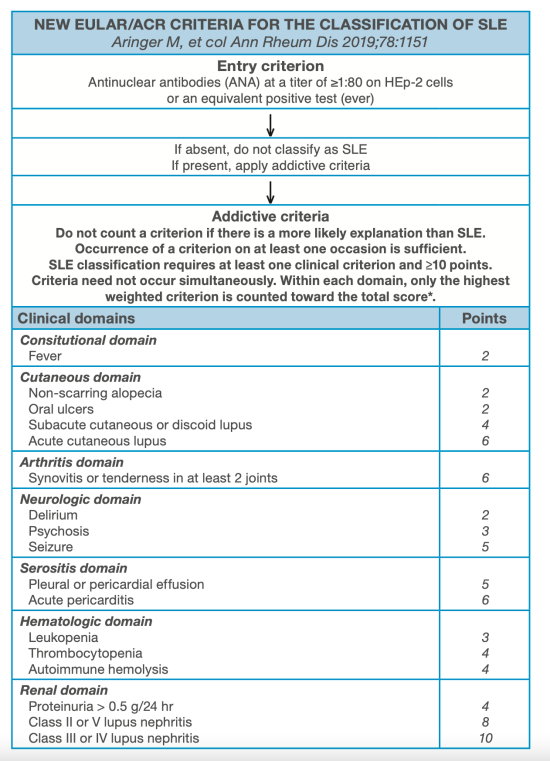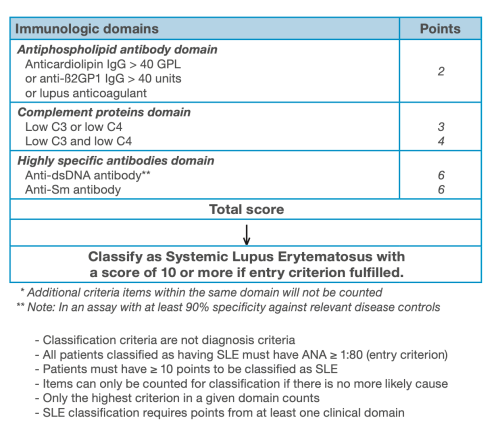Aneksi

Pregledajte sadržaj

Dodatak 1 - Kriteriijumi za aktivnost sistemskog lupusa
SLEDAI ili (Indeks aktivnosti bolesti sistemskog lupusa) daje uvid u aktivnost sistemskog lupusa. Težina koja je dodeljena svakoj varijabli određena je statističkom analizom na kohortama pacijenata sa sistemskim lupusom. Opisani događaji se uzimaju u obzir ako su prisutni na dan konsultacije ili u prethodnih 10 dana.
Ovaj SLEDAI-2K indeks aktivnosti uveden je pre 20 godina. Ovaj skor kombinuje kliničke i biološke kriterijume.
Dodatak 2 - Kriterijumi za klasifikaciju SLE (Sistemski eritematozni lupus)


Dodatak 3 - Lekovi za lupus.
Dodatak 3 • Lekovi za lupus. Abecedni red INN (Međunarodno nezaštićeno ime, eng.International Non-proprietary Name). Naznačene doze odgovaraju lečenju odraslih.
Glavne indikacije kod lupusa
Kao dodatna terapija za lečenje odraslih pacijenata sa umerenim do teškim, aktivnim autoantiteloima pozitivnim sistemskim lupusom eritematozusom (SLE), uprkos primeni standardne terapije.
Glavne indikacije kod lupusa
- Teške forme lupusa kod pacijenata koji su netolerantni na steroide, koji zavise od steroida ili kod kojih terapijski odgovor nije dovoljan uprkos lečenju visokim dozama steroida
- Udruženi autoimuni hepatitis
- Neke autoimune citopenije (smanjenje broja krvnih ćelija u krvi)
Glavne indikacije kod lupusa
U kombinaciji sa uobičajenom terapijom, kod odraslih pacijenata ili dece starije od 5 godina sa aktivnim sistemskim lupusom, prisutnošću autoantitela i visokim nivoom aktivnosti bolesti (definisano, na primer, prisustvom anti-DNA antitela i niskim nivoom komplementa) uprkos standardnom lečenju. Takođe može da se koristi za lečenje odraslih sa aktivnim lupusnim nefritisom koji primaju standardnu terapiju.
Nije indikovan za neurološke smetnje usled lupusa.
Glavna indikacija kod lupusa
-Svaki pacijent sa lupusom (kožni-artikularni i/ili visceralni lupus) treba, u principu, da bude lečen sintetičkim antimalaricima (hidroksiklorokinom ili hlorokinom), osim ako postoje kontraindikacije.
-Hlorokin se obično daje kao druga linija lečenja, u slučaju neuspeha ili netolerancije na hidroksiklorokin. Ovi lekovi pripadaju grupi sintetičkih antimalarika.
Glavne indikacije kod lupusa
Teške forme lupusa, posebno sa zahvatanjem bubrega ili centralnog nervnog sistema
Glavna indikacija kod lupusa
-Svaki pacijent sa lupusom (kožni, zglobni i / ili visceralni lupus) treba, u načelu, da bude na hidroksihlorokinu, osim ako postoji kontraindikacija.
-Hidroksihlorokin ima posebnu efikasnost na različite oblike kožnog lupusa, ali takođe smanjuje rizik od visceralnog zahvatanja (posebno oštećenja bubrega) i smanjuje rizik od posledica povezanim sa bolešću. Povezan je sa dužim preživljavanjem.
Glavna indikacija kod lupusa
Metotreksat nema odobrenje za upotrebu u lečenju lupusa, ali stručnjaci prepoznaju njegovu efikasnost u lupusu sa teškim zglobnim / kožnim zahvatanjem ili sa seroznim zahvatanjem (pleuritis, perikarditis).
Glavne indikacije kod lupusa
Mikofenolat mofetil (MMF) nema odobrenje za upotrebu kod lupusa, ali stručnjaci prepoznaju njegovu efikasnost u teškim oblicima lupusa, posebno u slučajevima teških oštećenja bubrega ili visceralnih oštećenja.
Glavne indikacije kod lupusa
Mikofenolat natrijum nema odobrenje za primene kod lupusa, ali stručnjaci prepoznaju njegovu efikasnost u teškim oblicima lupusa, posebno u slučajevima teških oštećenja bubrega ili visceralnih oštećenja.
Glavne indikacije kod lupusa
Lupus sa zglobnim ili visceralnim zahvatanjem (bubrezi, plućna maramica, perikard...)
Glavne indikacije kod lupusa
Lupus sa zglobnim ili visceralnim zahvatanjem (bubrezi, plućna maramica, perikard...)
Glavne indikacije kod lupusa
Rituksimab nema odobrenje za upotrebu kod lupusa, ali stručnjaci prepoznaju potencijalnu efikasnost u teškom lupusu, naročito u slučajevima teškog hematološkog, bubrežnog ili visceralnog zahvatanja.
Takrolimus (inhibitor kalcineurina) nema odobrenje za primene kod sistemskog lupusa, ali neki stručnjaci prepoznaju njegovu efikasnost u lupusu sa bubrežnim zahvatanjem, naročito u kombinaciji sa mikofenolat mofetilom.
Voklosporin (inhibitor kalcineurina) je odobren u kombinaciji sa osnovnim imunomodulatornim tretmanom za lečenje odraslih pacijenata sa aktivnim lupusnim nefritisom. Doza se ne bazira na telesnoj težini pacijenta. Ne treba pratiti koncentraciju leka u krvi.
Dodatak 4 - Lekovi za lupus i trudnoća i dojenje
- Aspirin u malim dozama (100 mg/dan)
- Hidroksihlorokin
- Azatioprin
- Kortikosteroidi
- Heparini niske molekulske mase
- Ciklosporin
- Takrolimus
NSAIL: hronična upotreba svih NSAIL (uključujući acetilsalicilnu kiselinu ≥ 500 mg/dan i COX-2 inhibitore) nije preporučena tokom trudnoće i formalno je kontraindikovana od 24. nedelje amenoreje.
Dojenje je najčešće moguće za sledeće lekove, ali je preporučljivo da se prethodno posavetujete sa lekarom:
Dodatak 5 - Lista zdravstvenih radnika u Evropi.
Lista je dostupna na veb sajtu:
ERN Reconnect: www. reconnet.ern-net.eu
Dodatak 6 - Leksikon
Glavni protein u krvi, albumin čini 50 do 65% proteina u krvnoj plazmi (tečnom delu krvi). Rastvorljiv je u vodi i proizvodi ga jetra, a nije deo globulina, koji su drugi proteini u krvi. Njegov nivo, nazvan albuminemija, iznosi oko 40 grama po litru krvi. Albumin se takođe nalazi u jajima (ovalbumin) i mleku (laktalbumin).
Termin proteinurija odnosi se na abnormalnu prisutnost proteina bilo koje vrste u urinu. Albuminurija se specifičnije odnosi na abnormalnu prisutnost određenog tipa proteina u urinu: albumina
Alopecija je gubitak kose na celokupnoj ili delimičnoj površini poglavine. Treba je razlikovati od ćelavosti, koja predstavlja potpuni gubitak kose.
Antitela, takođe nazvana imunoglobulini, su krvni proteini koje sintetišu određene ćelije imunog sistema (B limfociti i plazma ćelije) kao odgovor na ulazak stranog tela (antigena) u organizam.
Antikoagulansi su molekuli koji služe za usporavanje ili sprečavanje zgrušavanja krvi. Oni čine krv tečnijom i mogu izazvati krvarenje.
Antigen je supstanca strana našem organizmu (koju on obično ne poseduje) koja izaziva imuni odgovor sa antitelom.
Antimalarici su lekovi koji se koriste u lečenju ili prevenciji malarije. Neki antimalarici takođe imaju imunomodulatorna svojstva koja se koriste u lečenju autoimunih bolesti.
Artralgija je bol koji se javlja u zglobovima bez vidljivih spoljašnjih promena na zglobu. Bol se pojačava kada pacijent pomera zglob(ove) koji su zahvaćeni. Artralgija je česta i njen intenzitet zavisi od bolesti.
Ovaj naziv se koristi za akutna ili hronična upalna oboljenja koja utiču na zglobove i prate ih otoci sinovijalne membrane.
Ateromatoza je bolest zida krvnih sudova, delimično uzrokovana poremećajima masti (hiperholesterolemija, hipertrigliceridemija), ali i postojanjem hronične upalne bolesti, kao što je lupus.
Ovo su antitela koja telo proizvodi tokom autoimunih reakcija, kada pacijent nepravilno reaguje protiv sopstvenih imunih odbrambenih mehanizama. Autoantitelo je stoga usmereno protiv delova našeg sopstvenog organizma.
Biopsija je medicinski postupak koji uključuje uzimanje dela tkiva sa organa kako bi se proučilo. Njena glavna svrha je da pruži objektivne rezultate u određenim bolestima koje zahtevaju definitivnu dijagnozu.
Bioterapije se odnose na novu generaciju lekova. Po uzoru na prirodne biološke molekule, oni su slični ili identični proteinima koje proizvodi telo (enzimi, proteini, antitela).
Krvna slika je rezultat kvantitativnog i kvalitativnog proučavanja elemenata krvi, odnosno crvenih krvnih zrnaca, belih krvnih zrnaca i trombocita.
Hromozom (od grčkog "khroma" khroma : boja i "soma" : telo , element) je struktura koja se sastoji od DNK okružene proteinima.
Koagulacija je proces pretvaranja tečne krvi u polutečni gel. Ona uzrokuje formiranje ugruška i omogućava zaustavljanje krvarenja nakon povrede.
Pogledajte pitanje 46 .
Lek iz porodice imunosupresiva (pogledajte imunosupresiv).
Citokini su mali proteini koji deluju na ćelije različitih tipova, sa receptorima specifičnim za svaki od njih. Luče ih limfociti (bele krvne ćelije uključene u ćelijski imunitet) i makrofagi (ćelije odbrane odgovorne za varenje stranih čestica), i oni su uključeni u razvoj i regulaciju imunoloških odgovora.
Citopenija je pojam koji generalno definiše progresivno smanjenje broja ćelijskih linija.
Dijaliza (od grčkog dia: kroz, i luein: rastvoriti) se takođe naziva ekstrarenalno čišćenje i najčešće se izvodi pomoću veštačkog bubrega.
Dislipemija (od grčkog due: teškoća, lipos: mast, i haima: krv) je poremećaj (često prekomerna) holesterola i triglicerida. Nivoi holesterola i triglicerida treba da budu poznati kako bi ih ispravili ako je potrebno.
Ehografija je metoda ispitivanja koja koristi ultrazvuk i omogućava vizualizaciju određenih delova tela koji su obično skriveni od pogleda. Najčešće se koristi u obstetriciji (snimanje fetusa) i kardiologiji (srce i krvni sudovi),
Elektrokardiogram beleži električno funkcionisanje srca tokom njegovog ciklusa opuštanja i kontrakcije.
Elektromiogram je uređaj koji meri električnu aktivnost nerva i mišića. On prikuplja električnu aktivnost putem mikro-elektroda postavljenih u mišiću ili zalepljenih za kožu.
Enzim je biološki katalizator, odnosno molekul koji ubrzava hemijske reakcije metabolizma koje se dešavaju u ćelijskom ili vanćelijskom okruženju, i to i do miliona puta. Enzimi deluju u malim koncentracijama i ostaju netaknuti na kraju reakcije.
Fibromialgija je složena bolest koja se karakteriše prisustvom difuznih i višestrukih bolova, kao i određenih tačaka na telu koje su bolne na dodir. Takođe, prati je različite manifestacije, kao što su poremećaji spavanja
Hematurija je prisustvo krvi u urinu. Hematurija može biti makroskopska (tj. vidljiva), pri čemu urin dobija crvenu, roze ili braon boju i ponekad sadrži krvne ugruške.
Hemoliza je normalno ili patološko uništavanje crvenih krvnih zrnaca. Ovo uništavanje je rezultat više procesa, uključujući autoimunu hemolizu. Crveno krvno zrnce živi u proseku oko sto dana.
Glavobolje su bolovi u glavi, bez obzira na njihov uzrok. Obično nazivane "glavoboljama", one su locirane na lobanji, isključujući vrat i lice. Veoma su česte i jedan su od glavnih razloga za medicinske konsultacije. Migrena je jedan od glavnih uzroka.
Hipergamaglobulinemija je povećanje koncentracije gama globulina u serumu iznad 18 g/l. Ovo povećanje se nalazi tokom različitih inflamatornih sindroma ili tokom malignih proliferacija plazma ćelija.
Hipokomplementemija je nedostatak proteina komplementa u organizmu.
Hipoglikemija je smanjenje količine glukoze (šećera uopšte) ispod 0,5 g/l u krvi. Glukoza je glavna energetska supstanca koja može da nedostaje u mozgu.
Imunogenetika je proučavanje genetskih faktora koji su uključeni u mehanizme imunosti.
Termin imunosupresiv (ili imunokompromitovan) odnosi se na bilo šta što potiskuje ili ima sposobnost da smanji specifične imunološke reakcije tela protiv antigena (stranog tela koje ulazi u organizam).
Interferoni su deo citokina, malih proteina koje luče različite vrste ćelija uključenih u imunitet, a koji imaju regulativno i stimulativno delovanje na imuni sistem. Postoje tri vrste: interferon alfa; proizvode ga monociti;
Leukociturija je prisustvo leukocita, ili belih krvnih zrnaca, u urinu. Normalno, kroz urin se izlučuje samo nekoliko belih krvnih zrnaca. Leukociturija se javlja kada broj leukocita premaši 10.000 po ml.
Limfadenopatija se odnosi na oticanje limfnog čvora, adenomegaliju, upalne, infektivne ili tumorske prirode. Površinska limfadenopatija (vrat, pazuh, prepona) može se otkriti jednostavnim kliničkim pregledom.
Limfociti, vrsta belih krvnih zrnaca, učestvuju u imunološkom odgovoru. Postoje dve vrste: B limfociti (proizvodnja antitela) i T limfociti
Termin limfopenija se odnosi na smanjenje broja limfocita.
Makrofag je vrsta belih krvnih zrnaca, velike veličine, koja ima sposobnost da apsorbuje i uništava velike čestice poput oštećenih ili starih
Mijalgija je bol u mišićima. Takođe se javlja u različitim bolestima, akutnim ili hroničnim, mehaničkog, upalnog, hemijskog, infektivnog ili autoimunog porekla. Lečenje je usmereno na odgovarajuću bolest. Pored toga, za ublažavanje bola koriste se lokalni ili opšti analgetici i relaksanti.
Lumbalna punkcija je postupak uvođenja šuplje igle u donji deo kičme u medularni kanal. Omogućava uzimanje cerebrospinalne tečnosti koja okružuje korene i centralni nervni sistem,
MRI koristi magnetnu energiju protona kako bi sa velikom preciznošću proučila mnoge organe kao što su mozak, kičma, zglobovi i meka tkiva. Izuzetno je korisna kada je potrebna vrlo
Mijalgija je bol u mišićima. Takođe se javlja u različitim bolestima, akutnim ili hroničnim, mehaničkog, upalnog, hemijskog, infektivnog ili autoimunog porekla
Mijelogram je ispitivanje koštane srži koje se vrši pod lokalnom anestezijom. Sastoji se u analizi morfologije i ravnoteže različitih ćelija prisutnih u koštanoj srži.
Miozitis je upala poprečnoprugastog mišićnog tkiva koja vodi do bola i smanjenja mišićne snage, kao i povećanja nivoa enzima u krvi koji potiču iz mišića (kreatin kinaza).
Neutropenija je poremećaj krvi koji nastaje kada je broj neutrofila, jednog od tipova belih krvnih zrnaca prisutnih u krvi, abnormano nizak. Neutrofili učestvuju u borbi protiv
Neutrofili su polinuklearni neutrofili, kategorija belih krvnih zrnaca koja je sposobna da se bori protiv bakterijskih infekcija.
Nesteroidni antiinflamatorni lekovi, često skraćeno "NSAIL", su lekovi sa antiinflamatornim, kao i analgetskim i antipiretskim svojstvima, tj. smanjuju upalu, bol i groznicu. Termin "
Perikarditis (od grčkog peri: oko, kardia: srce, i završetak – itis: upala) se odnosi na upalu koja zahvata slojeve koji okružuju srce, perikard.
Flebitis se definiše kao stvaranje krvnog ugruška (tromboza) u veni, što je odgovorno za blokadu protoka krvi kroz tu venu. Vene donjih ekstremiteta su više pogođene nego vene ostatka tela, jer se krv tamo više zadržava
Fotosenzitivnost odražava preteranu osetljivost kože na sunčevo zračenje, posebno ultraljubičasto zračenje, što dovodi do osipa. Fotosenzitivnost može biti sekundarna usled uzimanja ili nanošenja proizvoda ili leka na kožu.
Placebo efekat je efekat koji se može primetiti uzimanjem tretmana koji ne sadrži aktivne sastojke. Ovaj placebo efekat,
Trombocit je figurativni element krvi koji se formira u koštanoj srži i fragmentira u male elemente.
Pleuritis (od grčkog pleuron: strana) je upala membrane koja pokriva i štiti pluća, pleura. Ova upala može se javiti ili akutno (relativno brzo)
Polinuklearna ćelija je ključna ćelija našeg tela jer je odgovorna za eliminaciju patogena, kao što su bakterije, nakon što ih imuni sistem prepozna.
Termin proteinurija se odnosi na abnormalnu prisutnost proteina, bilo koje vrste, u urinu. Abnormalna granica koja se obično koristi je 0,3 g/g kreatinina ili 0,3 g na 24 časa.
Remisija je snažno smanjenje ili nestanak privremenih simptoma bolesti.
Pravi se razlika između protokola osnovnog istraživanja, koji imaju za cilj poboljšanje razumevanja patofiziologije bolesti, i kliničkih i terapijskih protokola istraživanja, koji imaju za cilj procenu bolesti
Dodatak 7 - LUPUS EUROPE
LUPUS EUROPE je evropska krovna organizacija koja okuplja nacionalne organizacije pacijenata sa lupusom iz cele Evrope. To je neprofitna, nezavisna organizacija, koja ima za cilj da podrži i osnaži nacionalne organizacije članice, deli informacije sa njima i promoviše bolje procese usmerene na pacijente, kako u oblasti zdravstva, tako i na političkom nivou.
Od svog skromnog početka 1989. godine, LUPUS EUROPE je narasla i sada predstavlja većinu glavnih evropskih zemalja, koje zajedno predstavljaju više od 30.000 pacijenata u svojim članstvima. Danas se smatra vrednim partnerom na medicinskim konferencijama, u evropskim zdravstvenim organizacijama koje se bore za šira prava pacijenata i u evropskim inicijativama koje imaju za cilj poboljšanje zdravstvene zaštite i uspostavljanje „standarda lečenja“ za pacijente sa lupusom. LUPUS EUROPE je prepoznata od strane EMA (Evropske agencije za lekove, eng. Europaen Medicines Agency) i redovno je pozivana da pruži stavove pacijenata u vezi sa pitanjima novih tretmana. Važno je za našu zajednicu da ne delujemo samo na nacionalnom nivou, već i da dovedemo glasove pacijenata do prekograničnih tela i inicijativa za zdravstvenu zaštitu.
Vizija LUPUS EUROPE je: „Zadovoljavajući život za sve ljude sa lupusom u Evropi, dok ne postignemo svet bez lupusa“. Ova vizija usmerava ključne strategije: (a) da ljudi sa lupusom učestvuju u i imaju koristi od istraživanja lupusa; (b) da su organizacije članice entuzijastične i osnažene, i (c) da je Lupus Europe prisutna i aktivna u ključnim projektima. Ovi 3 strateški ciljevi su dalje podeljeni u niz projekata koje sprovodi LUPUS EUROPE, njeni članovi i volonteri.
LUPUS EUROPE je organizacija zasnovana na volonterizmu. Njom upravlja Odbor direktora sa sedam volontera, od kojih su svi ili oboleli od lupusa ili su blisko povezani sa osobom koja živi sa lupusom. Mali sekretarijat, koji takođe ima direktno iskustvo sa ovom bolešću, pruža podršku Odboru, a mreža od oko 40 volontera angažovana je na više projekata pažljivo odabranih kako bi podržala našu viziju i ključne strateške ciljeve.
Za više informacija o LUPUS EUROPE, posetite www.lupus-europe.org
Ako ste zainteresovani da volontirate za LUPUS EUROPE, kontaktirajte sekretarijat na se*********@**********pe.org
Da biste pronašli grupu pacijenata sa lupusom, člana LUPUS EUROPE, pogledajte u nastavku:
Mreža naših članova
- Evropa www.lupus-europe.org
- Belgija (Flamanski) www.cibliga.be
- Belgija (Francuski) www.lupus-belgium.org
- Bugarska www.revmatologia.org
- Hrvatska www.facebook.com/UdrugaCrveniLeptir
- Kipar www.rheumatism.org.cy
- Danska www.sle.dk
- Estonija www.facebook.com/luupuseselts
- Finska www.sle-yhdistys.fi
- Francuska www.lupusfrance.com
- Francuska www.lupusplus.com
- Nemačka www.lupus.rheumanet.org
- Grčka www.arthritis.org.gr
- Mađarska www.lupusz.hu
- Island www.gigt.is
- Izrael www.inbar.org.il
- Italija www.lupus-italy.org
- Litvanija www.facebook.com/groups/1570938559829856
- Nizozemska www.nvle.org
- Norveška www.sle.no
- Poljska www.3majmysierazem.pl
- Portugal www.lupus.pt
- Rusija www.revmo-nadegda.ru
- Slovačka www.klubmotylik.sk
- Slovenija www.revmatiki.si
- Španija www.felupus.org
- Švedska www.reumatikerforbundet.org
- Švajcarska www.lupus-suisse.ch
- Ujedinjeno Kraljevstvo www.lupusuk.org.uk
